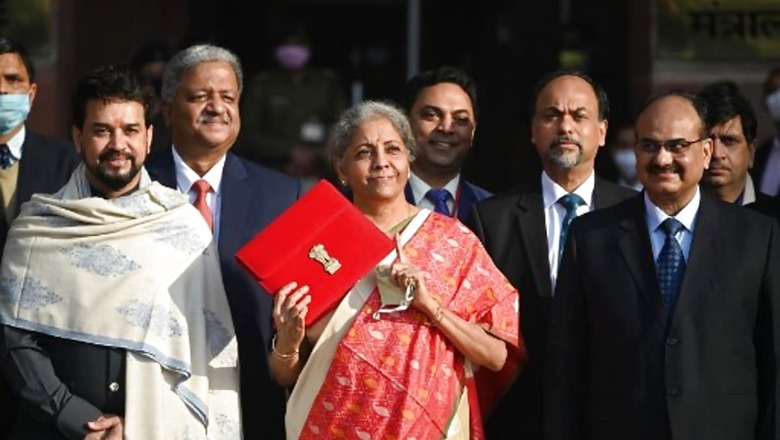
views
A century after Spanish Flu, the world was struck again by a devastating pandemic. India was not spared from it either. For almost a year now, people of India and the government, in unison, did all they could with a steely resolve to wither the storm and emerge victorious. The country did suffer but it also emerged stronger. In the midst of such a scenario, it is not easy to weave dreams for future, to aspire for a better tomorrow, and to keep goals intact without lowering guard. To make a budget in such times is an even more difficult proposition. On February 1, Union Finance Minister Nirmala Sitharaman did exactly that.
The most important aspect of this Budget is the conviction that has been exhibited by the Narendra Modi government in terms of not postponing the on-going work on developing the human, physical and financial infrastructure that India needs in her quest to become a $10 trillion economy by 2030-32. In other words, the Wuhan Virus, politely called Covid-19, could not rattle India. Developmental targets have been kept steady and not allowed to get swayed by the pandemic.
Focus on Health Infrastructure
If there are two critical lessons that the Covid-19 crisis taught us as a nation, they are the following. First, India realized the need to massively augment institutional capacity of all district hospitals, and not restrict them to a few AIIMS or select super-specialty hospitals.
Second, development of critical health infrastructure is as important for the nation, as it is to develop physical and financial infrastructure, to make sure that aspirations for a better future are not inhibited by weak health infrastructure and its subsequent impact on workforce.
It is good to see that one of the biggest hallmarks of this year’s Budget has been the focus on augmentation of the health infrastructure. Apart from the National Health Mission, the real centerpiece among the announcements related to allocations for health sector is the Pradhan Mantri Atmanirbhar Swasth Bharat Yojana. To be spread over the next six years with an outlay of Rs 64,180 crore, the core objective of this programme is to provide institutional support to an estimated 17,000 rural and 11,000 urban health and wellness centres, in addition to integrated public health labs in each district, coupled with public health units across 11 states of India.
In addition to this, one key focus of this scheme would be to provide fund for development of critical care blocks across 602 district hospitals and 12 central hospitals. Further, the government has allocated a whopping Rs 35,000 crore for Covid-19 vaccination, an indication that the Modi government would strive to reach out to maximum people for the Covid-19 vaccination drive.
Pradhan Mantri Atmanirbhar Swasth Bharat Yojana is not an expenditure, but rather an investment by the Government of India to facilitate capacity augmentation for future pandemic-related crisis, in case they ever happen again. The entire allocation for health to the tune of Rs 2,23,846 crore, including Rs 60,030 crore earmarked for drinking water and sanitation projects, should be seen through the prism of investment for the future.
ALSO READ| Union Budget 2021: Finance Minister Nirmala Sitharaman Refuses to Embark on Path of Fiscal Irresponsibility
The Infra Push to Achieve Twin Goals
As expected, the Budget gave a massive push to spending on infrastructure development. While most analysts have perceived it as means to boost demand in the economy in the post-pandemic scenario, it also has to be remembered that capacity augmentation of key infrastructure is essential to enhance the ability of the economy to absorb future investments. With India aiming to become a $10 trillion economy in the next decade, the infrastructure push was both inevitable and indispensable.
The Budget, therefore, saw major impetus being given to Kerala, Tamil Nadu, West Bengal and Assam—an estimated Rs 2,27,000 crore would be spent to construct thousands of kilometers of national highways in these four states over the next few years. The Ministry of Road Transport, which is working on the mammoth Bharatmala Project for highways construction, got the highest allocation of Rs 1,08,230 crore for capital expenditure alone this year.
In addition to this, the Rural Infrastructure Development Fund got its allocation enhanced from Rs 30,000 crore to Rs 40,000 crore. Further, city gas distribution network would add 100 more districts in three years to spread its network. An interesting aspect of this year’s Budget is the sustained focus of the government to promote diversification of agriculture and allied activities by continuing investments in requisite infrastructure to boost fisheries, horticulture and dairy sector. This is important since paddy- and wheat-focused agriculture in India is both self-defeating and unsustainable.
In all, for the FY-2021-22, the government has earmarked Rs 5.54 lakh crore for capital expenditure, which is an extremely positive and bold step to push economic activity and job creation in the post-pandemic crisis era. It is a known fact that capital expenditure especially on infrastructure gives a major impetus to demand for cement, steel, construction activities as well as associated tertiary works. Likewise, in another bold step, the government allocated an additional Rs 2 lakh crore for states to spend for capital expenditure, and which would be over and above the central outlay.
Push for Making Railways Future-Ready
For the rail sector, one the most critical transport infrastructure, this year’s allocation witnessed highest-ever plan for capital expenditure, to the tune of a whopping Rs 2,15,058 crore, of which Rs 1,07,100 crore is being allocated from the Union Budget while the Indian Railways would take care of the rest through internal resources and extra budgetary avenues. Likewise, the Budget made allocations of an estimated Rs 87,000-Rs 88,000 crore for several of the ongoing metro rail projects, which includes Chennai Metro, Bangalore Metro, Nagpur Metro, Nashik Metro and Kochi Metro projects.
Apart from announcing the introduction of a new range of MetroLite and MetroNeo projects for India’s Tier-2 cities and areas in the periphery of Tier-1 cities, the government showed its intent towards building a $10 trillion economy by announcing the creation of a future-ready railways system by 2030 and its template has already been created through the National Rail Plan for 2030 drafted by the Indian Railways. This has to be looked from the perspective of a series of reforms already initiated in the rail sector, including decision to allow private sector to run trains as well as massive revamp of key rail stations and operationalization of Dedicated Freight Corridor, which as and when gets completed by 2022, is expected to usher in a new level of logistics efficiency in India.
Provisioning for Infrastructure Finance
In fact, one of the pivotal points of this year’s Budget has been the plan for creation of a new Development Financial Institution, with an initial equity contribution of Rs 20,000 crore by the Government of India, which will lend Rs 5 lakh crore over the next three years. This is a landmark decision because the government is not just laying the roadmap for massive infrastructural investments but also making sure that availability of finances for such long-term infrastructural projects does not remain a constraint.
World over, infrastructure projects are generally financed by the Development Finance Institutions (DFI) rather than commercial banks, and if such DFIs have sovereign backing, then it becomes much easier for such institutions to leverage considerably for financing long-term infrastructure projects which may have huge gestation periods. One has to remember that in countries like China, it is state-owned development finance institutions like the China Development Bank that played a critical role in sustained financing of long-term infrastructure projects, often by over-leveraging. India would need to tread on similar lines, and is planning to do it now.
ALSO READ| With Bold Position on Fiscal Deficit, This is Not a One-off, Flash-in-the-Pan Budget
Betting Big on Bold Reforms
If some of the critics of the Modi government were desperately hoping that the farm law protests or the pandemic-related crisis would deter it from going ahead with the reform agenda, then certainly it did not happen that way. Government has shown willingness to continue with the reform agenda, knowing well that it would invariably face stiff resistance from certain quarters. But with a massive mandate to cushion it inside Parliament and general elections being more than three years away, it is clear that a slew of pending reforms that also have the potential to lay the foundation for India’s next-generation quantum leap in economic sphere would be initiated by the government, come what may.
FDI Hike in Insurance and Bank Divestment
Among some of the key reforms initiated in this Budget is to allow the FDI in the insurance sector to go up to the level of 74 per cent from the present 49 per cent, which is expected to bring considerable amount of capital into the Indian market. While the opposition nevertheless would raise the bogus bogey of resistance against this move, reality is that the Indian insurance sector now is resilient enough and surveilled by an extremely proactive regulatory authority, namely the Insurance Regulatory and Development Authority (IRDA). Therefore, it is the right moment to allow 74 per cent FDI in the sector.
However, in terms of statement of intent, an even bigger reform in the financial sector is the Finance Minister’s announcement that the government would divest stake in two Public Sector Banks (PSBs) and one state-owned general insurance company in addition to the ongoing privatization of the IDBI Bank. While the names of the banks have not been specified yet, the move can be considered as a logical culmination post consolidation of the public sector banks initiated by Modi government, wherein a large number of PSBs were merged to make around half a dozen robust banks of global scale.
The divestment of PSBs makes absolute sense simply because the state-owned banks have lived past their shelf life in terms of their ability to cater to the needs of a young and aspirational India. The traditional banking culture of public sector banks has to pave way for new age banks, which would have capital backing as well as nimble-footed agility. For far too long, PSBs functioned without bothering much about NPAs, knowing well that eventually the government would bail them out if the situation demands. This cannot go on for perpetuity. Indian public sector banks need to stand on their own feet and become competitive enough to deliver the best. And for that, divestment of the government stake to pave way for more private capital and efficiency is a must. It is also expected that with pandemic crisis on the wane, disinvestment of PSUs like BPCL and Air India would be completed.
PPP for Major Ports: Game-Changing Reform
From the perspective of boldness of reforms, the proposal for implementing the Public Private Partnership (PPP) model for managing the operational aspects of India’s major ports is also a welcome move for enhancing port efficiency. A look at how the Delhi Airport has metamorphosed from a moribund edifice of socialist India to a world-class airport with globally competitive scale and efficiency illustrates how the PPP model can help in capacity building for India’s critical economic infrastructure, such as airports and seaports.
India’s aspiration to reach the $10 trillion threshold would remain hamstrung by the institutional inefficiency of India’s ports unless these reforms are implemented. India needs ports that have scales and turnaround times comparable to those of Singapore and China. The PPP model is perfectly suited to take care of that.
Unshackling Power Sector
Among other key measures announced in the Budget include a clear cut roadmap for reforms in electricity distribution sector, for which around Rs 3 lakh crore has been earmarked over the next five years. This will make sure that the perpetual viability challenges that plague India’s electricity distribution companies (discoms) are addressed by ensuring that liquidity support from the central government for infrastructure upgradation in electricity distribution companies is linked to efforts made by them in implementation of prepaid smart metering systems and separation of feeder systems—all aimed at reducing their humongous losses.
Further, the budget also mentioned the need to develop a framework for encouraging competition among the discoms and giving consumers the choice to choose from several operators. A vibrant, productive and remunerative distribution architecture is necessary for India’s power sector to thrive and this is perhaps the last chance to take discoms out of their perpetual comatose state. Without the end market being competitive, feasible and remunerative, investments in India’s power generation alone would achieve little.
Monetisation Pipeline: Unleashing Intrinsic Wealth
A key issue that has been explicitly mentioned in this Budget is the intent of the government to monetise brownfield infrastructure assets through the creation of a National Monetisation Pipeline. At a time when major impetus is being given to create infrastructure for future, it makes perfect sense for the Government of India to monetise its assets such as highways, gas pipelines, freight corridors and huge repository of land holdings in excess of 5,00,000 hectares, for unleashing their real value and also triggering massive investments in certain sectors. New age India cannot afford to waste opportunities by not leveraging the intrinsic wealth hidden in idle assets that can be monetised for funding capital expenditure wherever needed.
PLI Boost to Industry
Given the fact that India’s GDP is disproportionately skewed towards services sector, there was always a huge scope for increasing the share of the industry in the same. A list of measures has been taken over the last few years to address some of the pertinent issues including labour-related norms, making corporate tax rates comparable to global benchmarks and allowing 100 per cent FDI in contract manufacturing.
In continuation to that, the announcement made by Finance Minister to spend Rs 1.97 lakh crore over the next five years for 13 sectors, as part of a Production Linked Incentive (PLI) scheme, can give a major fillip to manufacturing in India. This is much-needed if India has to position itself as a viable alternative to China in terms of being a global production hub. The measures taken also have to be seen in the larger context of announcements already made as part of Atmanirbhar Bharat initiatives last year, wherein key steps were taken to boost the prospects of the MSME sector by changing the definition of MSME as well as doing away with global tendering for contracts up to Rs 200 crore. The meteoric rise of India’s mobile manufacturing sector to become the second-largest manufacturer in the world is a reflection of what can be achieved if right steps are taken.
ALSO READ| Tax Proposals Falling Short of Rationalisation of Direct Tax Structure But Sufficient to Give Relief to Taxpayer
Keep Anarchists at Bay
Last but not the least, an allocation of nearly $50 billion for defence, excluding pension out-go, not increasing personal or corporate income tax in spite of pandemic challenges, and by giving the entire food subsidy through Budget instead of provisioning for it through loans from NSSF (National Social Security Fund), some reasonably good steps have been taken that would pave way for a more confident, bold and transparent India. In spite of major challenges, the pace has been set for future course and Modi government deserves to be applauded.
Nevertheless, India would still need to remember two important things. One, without agriculture market reforms, it is well-nigh impossible for India to improve the quality of life for all its 1.3 billion people, and thus, in spite of resistance from vested interests, the government should stay firm on the agriculture market reforms it has started. Second, no amount of good work is enough to take India to the next league unless the rabble-rousers and anarchists are kept at bay. Government and its agencies must stay vigilant.
Read all the Latest News, Breaking News and Coronavirus News here




















Comments
0 comment